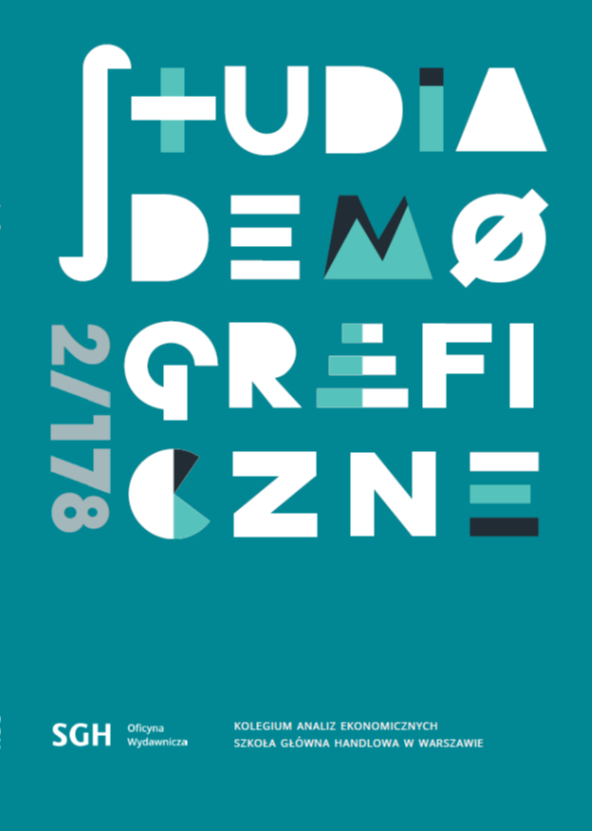Sezonowe wahania umieralności w wybranych państwach Europy Środkowo-Wschodniej i Zachodniej
Main Article Content
Abstract
The report concerns analysis of seasonal patterns of mortality for selected countries of Central and Eastern Europe, compared with France, Italy and Germany, based on monthly Eurostat data from 1999 to 2019. In the literature it is known that increase of mortality rates in winter is typical for the North Hemisphere. We show that there are similarities and differences in the pattern – both in the averages and volatility – of this increase in particular countries. To this aim the , and seasonality measures, known in the literature, were applied. The results are visualized in graphical and tabular form. In addition, significance of this seasonal variation is tested based on the regression with binary seasonal variables.
Article Details
References
Akaike, H. (1974). A new look at the statistical model identification, IEEE Transactions on Automatic Control AC, 19, s. 716–723. DOI: 10.1109/TAC.1974.1100705.
Bull, G. M., Morton, J. (1978). Environment, Temperature and Death Rates, Age and Ageing, 7, s. 210–224. DOI: 10.1093/ageing/7.4.210. pubmed.ncbi.nlm.nih.gov/727071/.
Falagas, M. E., Karageorgopoulos, D. E., Moraitis, L. I., Vouloumanou, E. K., Roussos, N., Peppas, G., Rafailidis, P. I. (2009). Seasonality of mortality: The September phenomenon in Mediterranean countries, CMAJ, 181 (8), s. 484–486. DOI: 10.1503/cmaj.090694. www.ncbi.nlm.nih.gov/pmc/articles/PMC2761439/.
Grut, M. (1987). Cold-related death in some developed countries, The Lancet, 8526: 212. DOI: 10.1016/S0140–6736 (87) 90019–5.
Healy, J. D. (2003). Excess winter mortality in Europe: a cross country analysis identifying key risk factors, J Epidemial Community Health, 57, s. 784–789, www.ncbi.nlm.nih.gov/pmc/articles/PMC1732295/.
Hyndman, R. J., Athanasopoulos, G. (2018). Forecasting: principles and practice (2nd ed.). OTexts: Melbourne, Australia. OTexts.com/fpp2 (dostęp: 15.10.2020).
Lauc, G., Markotic, A., Gornik, I., Primorac, D. (2020). Fighting COVID-19 with water, Journal of Global Health, Vol. 10, jogh.org/documents/issue202001/jogh-10–010344.pdf.
Ljung, G. M., Box, G. E. P. (1978). On a measure of lack of fit in time series models, Biometrika, Vol. 65, Iss. 2, s. 297–303. DOI: 10.1093/biomet/65.2.297.
Mazzi, G. L. (ed.). (2018). Handbook on seasonal adjustment, 2018 edition, Luxembourg: Publications Office of the European Union, ec.europa.eu/eurostat/documents/3859598/8939616/KS-GQ-18–001‑EN-N.pdf.
Mielecka-Kubień, Z. (2018). Sezonowość zgonow w Polsce w latach 2012–2015, Studia Ekonomiczne. Zeszyty Naukowe Uniwersytetu Ekonomicznego w Katowicach, 375.
Newey, W. K., West, K. D. (1987). A simple, positive semi-definite, heteroskedasticity and autocorrelation consistent covariance matrix, Econometrica, 55, s. 703–708.
Nobbe, K. (2017). Seasonality of Mortality, Reflections RGA’s Global Magazine, Vol. 40, s. 8–13, www.rgare.com/knowledge-center/media/articles/seasonality-of-mortality.
Rau, R. (2007). Seasonality in Human Mortality: A Demographic Approach. Springer.
Schwarz, G. E. (1978). Estimating the dimension of a model, Annals of Statistics, 6 (2), s. 461–464. DOI: 10.1214/aos/1176344136.
Wojtyniak, B., Rabczenko, D., Czarkowski, M., Skotak, K. (2018). Ocena przyczyn podwyższonej umieralności ludności Polski na początku 2017 roku. Warszawa: Narodowy Instytut Zdrowia Publicznego – Państwowy Zakład Higieny, www.pzh.gov.pl.
Wroblewska, W. (2019), Zmiana liczby zgonow i trwania życia w latach 2016–2018. Przyczynek do analizy zgonow w Polsce, Studia Demograficzne, 1 (175), s. 9–25, econjournals. sgh.waw.pl/SD/article/view/2335/2066. DOI: 10.33119/SD.2019.1.1.
Baza danych Eurostatu
ec.europa.eu/eurostat/databrowser/view/demo_mmonth/default/table?lang=en (dostęp: 25.08.2020).
ec.europa.eu/eurostat/databrowser/view/demo_gind/default/table?lang=en (dostęp: 25.08.2020).
